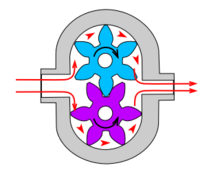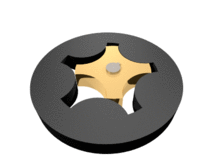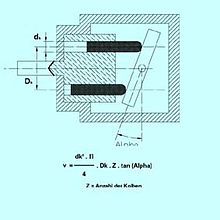Hydraulic pump: Difference between revisions
No edit summary |
|||
| Line 17: | Line 17: | ||
===Gerotor pumps=== |
===Gerotor pumps=== |
||
[[Gerotor]] pumps (fixed displacement) are a variation of gear pumps, having internal teeth of optimized design. The efficiency and noise level are very good for such a medium pressure pump. |
[[Gerotor]] pumps (fixed displacement) are a variation of gear pumps, having internal teeth of optimized design. The efficiency and noise level are very good for such a medium pressure pump.vb |
||
===Rotary vane pumps=== |
===Rotary vane pumps=== |
||
Revision as of 15:38, 4 March 2010








Hydraulic pumps are used in hydraulic drive systems and can be hydrostatic or hydrodynamic.
Hydrostatic pumps are positive displacement pumps while hydrodynamic pumps can be fixed displacement pumps, in which the displacement (flow through the pump per rotation of the pump) cannot be adjusted, or variable displacement pumps, which have a more complicated construction that allows the displacement to be adjusted.
Hydraulic pump types
Gear pumps
Gear pumps (with external teeth) (fixed displacement) are simple and economical pumps. The swept volume or displacement of gear pumps for hydraulics will be between about 1 cm3 (0.001 litre) and 200 cm3 (0.2 litre). These pumps create pressure through the meshing of the gear teeth, which forces fluid around the gears to pressurize the outlet side. Some gear pumps can be quite noisy, compared to other types, but modern gear pumps are highly reliable and much quieter than older models.
Gerotor pumps
Gerotor pumps (fixed displacement) are a variation of gear pumps, having internal teeth of optimized design. The efficiency and noise level are very good for such a medium pressure pump.vb
Rotary vane pumps
Rotary vane pumps (fixed and simple adjustable displacement) have higher efficiencies than gear pumps, but are also used for mid pressures up to 180 bars in general. Some types of vane pumps can change the centre of the vane body, so that a simple adjustable pump is obtained. These adjustable vane pumps are in general constant pressure or constant power pumps: the displacement is increased until the required pressure or power is reached and subsequently the displacement or swept volume is decreased until an equilibrium is reached.
Screw pumps
Screw pumps (fixed displacement) are a double Archimedes spiral, but closed. This means that two screws are used in one body. The pumps are used for high flows and relatively low pressure (max 100 bar). They were used on board ships where the constant pressure hydraulic system was going through the whole ship, especially for the control of ball valves, but also for the steering gear and help drive systems. The advantage of the screw pumps is the low sound level of these pumps; the efficiency is not that high.
Bent axis pumps
Bent axis pumps, axial piston pumps and motors using the bent axis principle, fixed or adjustable displacement, exists in two different basic designs. The Thoma-principle (engineer Hans Thoma, Germany, patent 1935) with max 25 degrees angle and the Wahlmark-principle (Gunnar Axel Wahlmark, patent 1960) with spherical-shaped pistons in one piece with the piston rod, piston rings, and maximum 40 degrees between the driveshaft centerline and pistons (Volvo Hydraulics Co.). These have the best efficiency of all pumps. Although in general the largest displacements are approximately one litre per revolution, if necessary a two-liter swept volume pump can be built. Often variable-displacement pumps are used, so that the oil flow can be adjusted carefully. These pumps can in general work with a working pressure of up to 350–420 bars in continuous work.
Axial piston pumps swashplate principle
Axial piston pumps using the swashplate principle (fixed and adjustable displacement) have a quality that is almost the same as the bent axis model. They have the advantage of being more compact in design. The pumps are easier and more economical to manufacture; the disadvantage is that they are more sensitive to oil contamination.
Radial piston pumps
Radial piston pumps (fixed displacement) are used especially for high pressure and relatively small flows. Pressures of up to 650 bar are normal. In fact variable displacement is not possible, but sometimes the pump is designed in such a way that the plungers can be switched off one by one, so that a sort of variable displacement pump is obtained.
Peristaltic pumps
Peristaltic pumps are not generally used for high pressures.
Pumps for open and closed systems
Most pumps are working in open systems. The pump draws oil from a reservoir at atmospheric pressure. It is very important that there is no cavitation at the suction side of the pump. For this reason the connection of the suction side of the pump is larger in diameter than the connection of the pressure side. In case of the use of multi-pump assemblies, the suction connection of the pump is often combined. It is preferred to have free flow to the pump (pressure at inlet of pump at least 0.8 bars). The body of the pump is often in open connection with the suction side of the pump.
In case of a closed system, both sides of the pump can be at high pressure. The reservoir is often pressurized with 6-20 bars boost pressure. For closed loop systems, normally axial piston pumps are used. Because both sides are pressurized, the body of the pump needs a separate leakage connection.
Multi pump assembly
In a hydraulic installation, one pump can serve more cylinders and motors. The problem however is that in that case a constant pressure system is required and the system always needs the full power. It is more economic to give each cylinder and motor its own pump. In that case multi pump assemblies can be used. Gearpumps can often be obtained as multi pumps. The different chambers (sometimes of different size) are mounted in one body or built together. Also vane pumps can often be obtained as a multi pump. Gerotor pumps are often supplied as multi pumps. Screw pumps can be built together with a gear pump or a vane pump. Axial piston swashplate pumps can be built together with a second pump of the same or smaller size, or can be built together with one or more gear pumps or vane pumps (depending on the supplier). Axial plunger pumps of the bent axis design can not be built together with other pumps.
Hydraulic pumps, calculation formulas
Flow
Q = n * Vstroke *η vol
Q = Flow in m3/s
n = revs per second
Vstroke = swept volume in m3
η vol is volumetric efficiency
Power
P = n * Vstroke * Δp / ηmech,hydr
P = Power in Watt (Nm/s)
n = revs per second.
Vstroke = swept volume in m3
Δp = pressure difference over pump in N/m2
ηmech,hydr = mechanical/hydraulic efficiency
External links
See also
